Governance, Stewardship, and CSR: A Case Study of Exxon Mobil & TEPCO
VerifiedAdded on 2023/06/04
|5
|996
|218
Case Study
AI Summary
This document presents a case study analysis of Exxon Mobil and TEPCO, focusing on governance, stewardship, and corporate social responsibility (CSR). The Exxon Mobil case examines shareholder motions advocating for reduced greenhouse gas emissions and increased renewable energy research. The TEPCO case investigates board structure failures contributing to a catastrophic event, highlighting discrepancies between alleged corporate governance concerns and actual outcomes. The analysis provides recommendations for both companies, emphasizing the importance of independent board members, risk management, and transparent communication with stakeholders. The document concludes with references in APA format, offering a comprehensive overview of the governance challenges and potential solutions for these organizations.
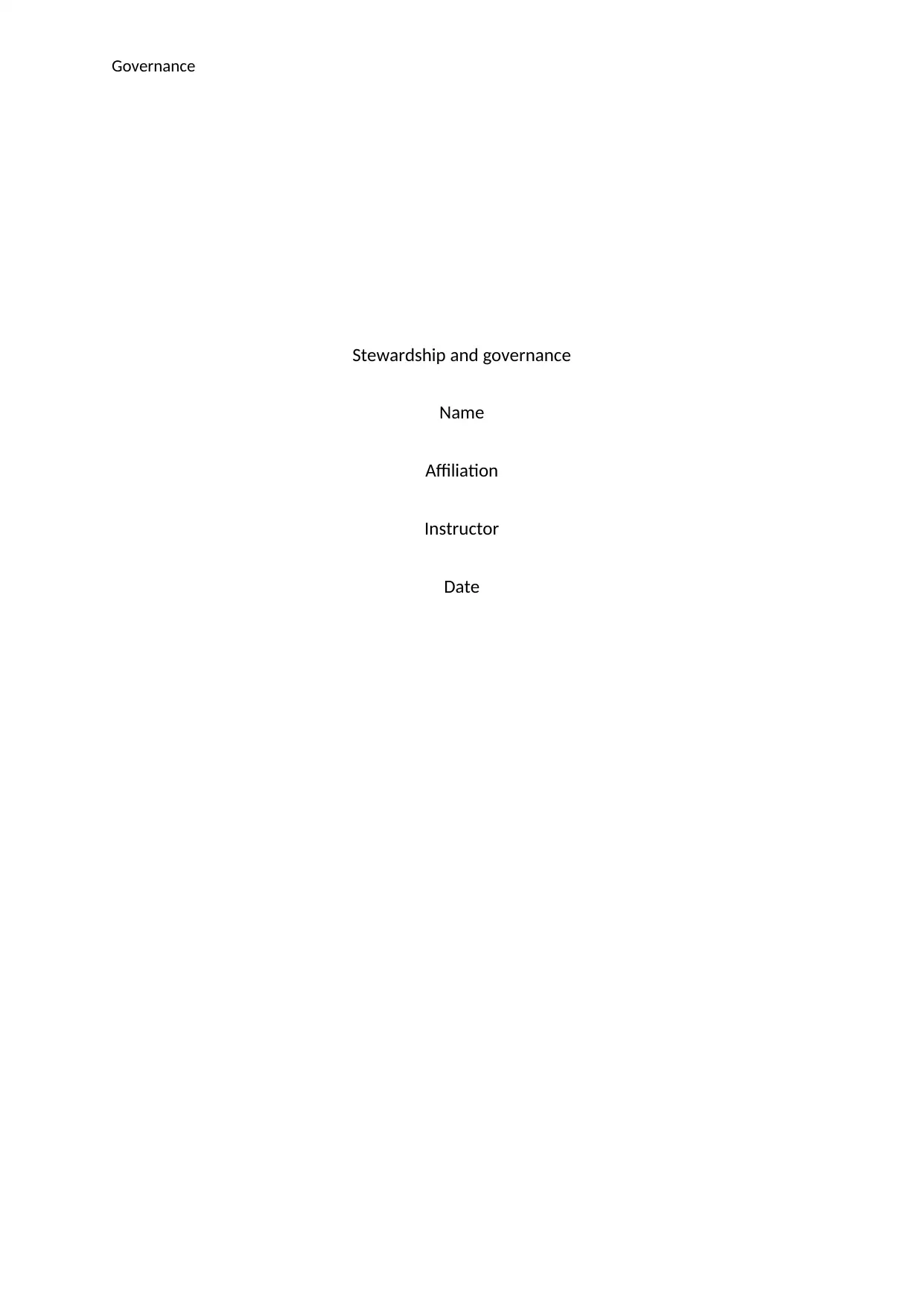
Governance
Stewardship and governance
Name
Affiliation
Instructor
Date
Stewardship and governance
Name
Affiliation
Instructor
Date
Paraphrase This Document
Need a fresh take? Get an instant paraphrase of this document with our AI Paraphraser
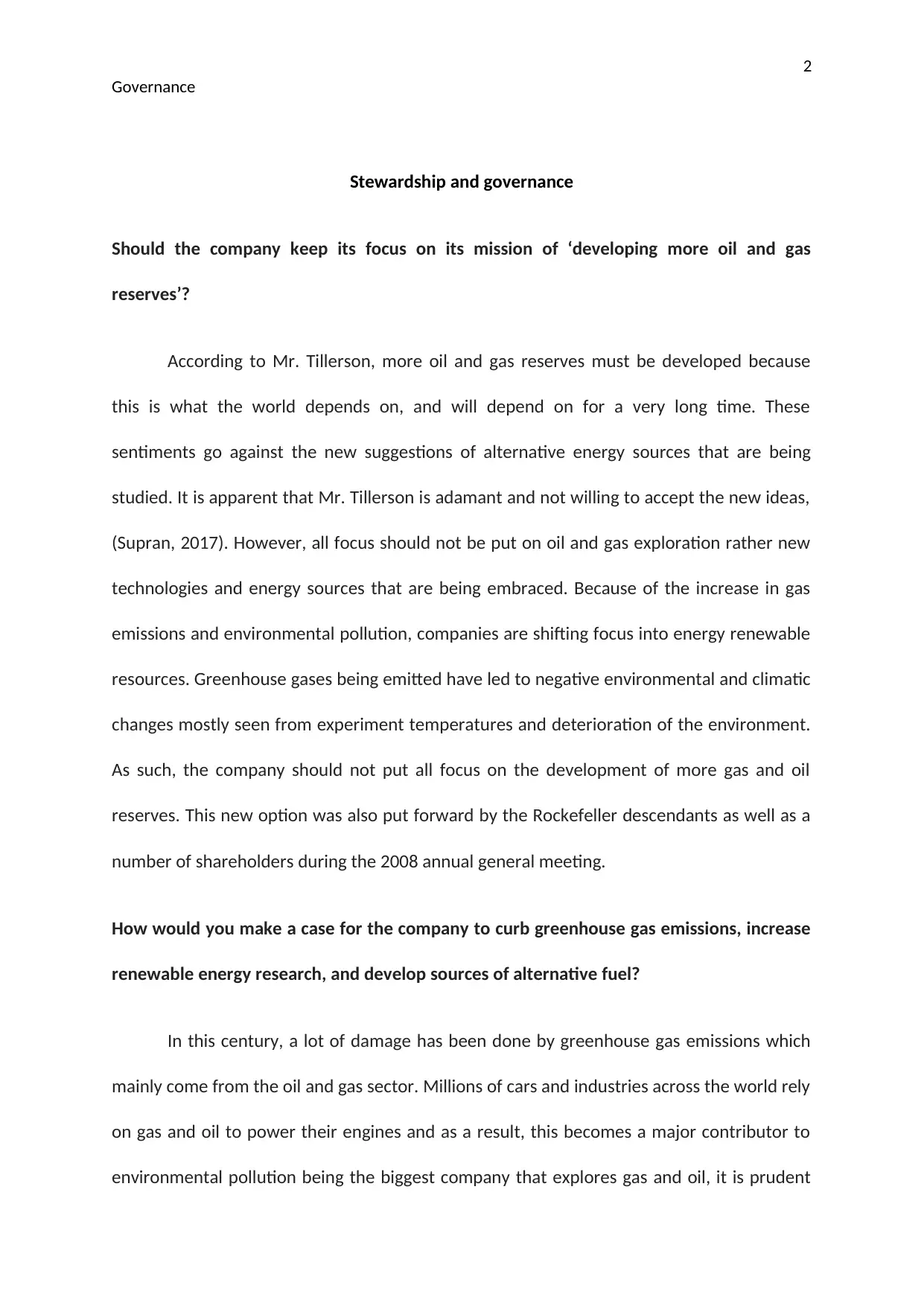
2
Governance
Stewardship and governance
Should the company keep its focus on its mission of ‘developing more oil and gas
reserves’?
According to Mr. Tillerson, more oil and gas reserves must be developed because
this is what the world depends on, and will depend on for a very long time. These
sentiments go against the new suggestions of alternative energy sources that are being
studied. It is apparent that Mr. Tillerson is adamant and not willing to accept the new ideas,
(Supran, 2017). However, all focus should not be put on oil and gas exploration rather new
technologies and energy sources that are being embraced. Because of the increase in gas
emissions and environmental pollution, companies are shifting focus into energy renewable
resources. Greenhouse gases being emitted have led to negative environmental and climatic
changes mostly seen from experiment temperatures and deterioration of the environment.
As such, the company should not put all focus on the development of more gas and oil
reserves. This new option was also put forward by the Rockefeller descendants as well as a
number of shareholders during the 2008 annual general meeting.
How would you make a case for the company to curb greenhouse gas emissions, increase
renewable energy research, and develop sources of alternative fuel?
In this century, a lot of damage has been done by greenhouse gas emissions which
mainly come from the oil and gas sector. Millions of cars and industries across the world rely
on gas and oil to power their engines and as a result, this becomes a major contributor to
environmental pollution being the biggest company that explores gas and oil, it is prudent
Governance
Stewardship and governance
Should the company keep its focus on its mission of ‘developing more oil and gas
reserves’?
According to Mr. Tillerson, more oil and gas reserves must be developed because
this is what the world depends on, and will depend on for a very long time. These
sentiments go against the new suggestions of alternative energy sources that are being
studied. It is apparent that Mr. Tillerson is adamant and not willing to accept the new ideas,
(Supran, 2017). However, all focus should not be put on oil and gas exploration rather new
technologies and energy sources that are being embraced. Because of the increase in gas
emissions and environmental pollution, companies are shifting focus into energy renewable
resources. Greenhouse gases being emitted have led to negative environmental and climatic
changes mostly seen from experiment temperatures and deterioration of the environment.
As such, the company should not put all focus on the development of more gas and oil
reserves. This new option was also put forward by the Rockefeller descendants as well as a
number of shareholders during the 2008 annual general meeting.
How would you make a case for the company to curb greenhouse gas emissions, increase
renewable energy research, and develop sources of alternative fuel?
In this century, a lot of damage has been done by greenhouse gas emissions which
mainly come from the oil and gas sector. Millions of cars and industries across the world rely
on gas and oil to power their engines and as a result, this becomes a major contributor to
environmental pollution being the biggest company that explores gas and oil, it is prudent
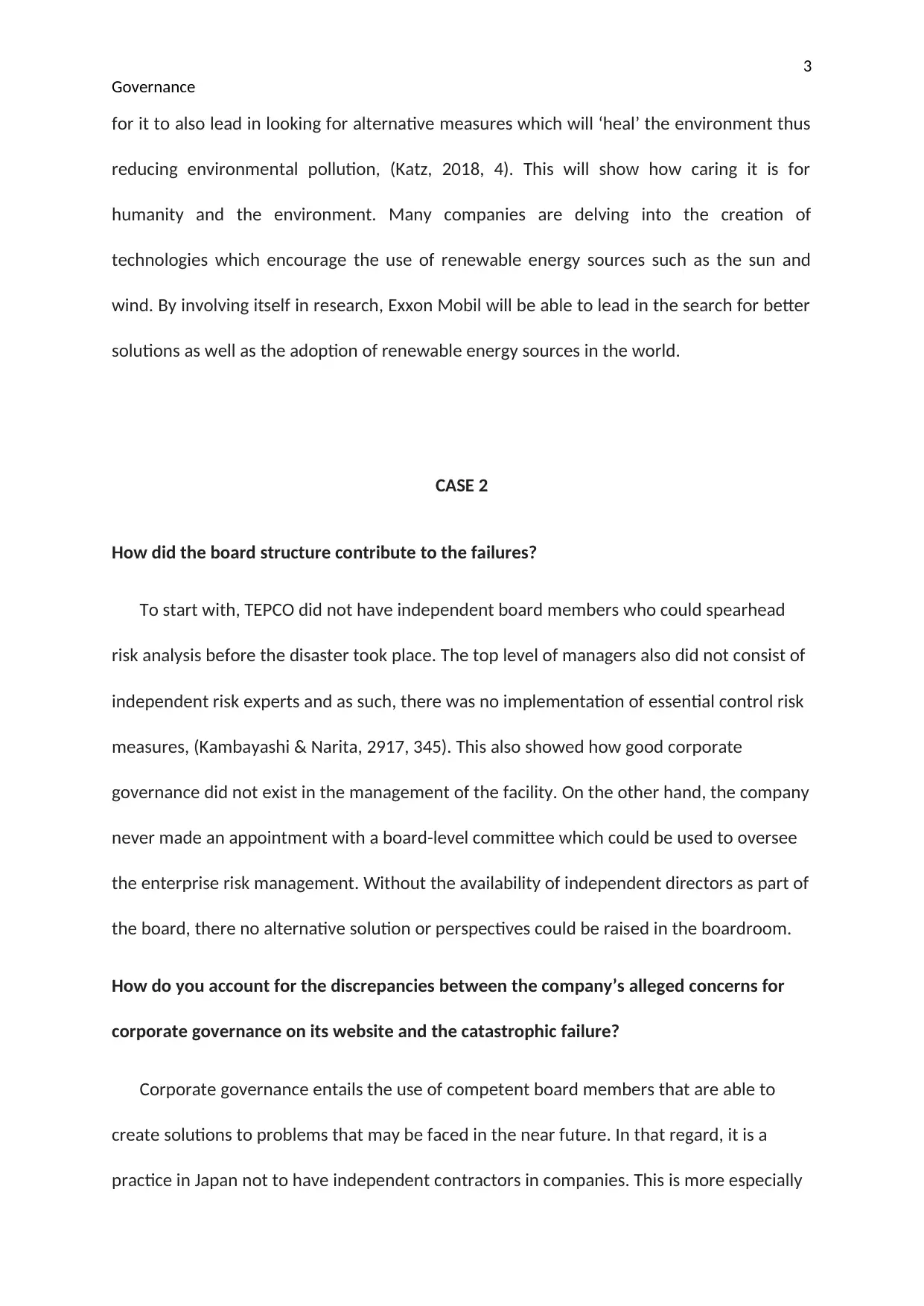
3
Governance
for it to also lead in looking for alternative measures which will ‘heal’ the environment thus
reducing environmental pollution, (Katz, 2018, 4). This will show how caring it is for
humanity and the environment. Many companies are delving into the creation of
technologies which encourage the use of renewable energy sources such as the sun and
wind. By involving itself in research, Exxon Mobil will be able to lead in the search for better
solutions as well as the adoption of renewable energy sources in the world.
CASE 2
How did the board structure contribute to the failures?
To start with, TEPCO did not have independent board members who could spearhead
risk analysis before the disaster took place. The top level of managers also did not consist of
independent risk experts and as such, there was no implementation of essential control risk
measures, (Kambayashi & Narita, 2917, 345). This also showed how good corporate
governance did not exist in the management of the facility. On the other hand, the company
never made an appointment with a board-level committee which could be used to oversee
the enterprise risk management. Without the availability of independent directors as part of
the board, there no alternative solution or perspectives could be raised in the boardroom.
How do you account for the discrepancies between the company’s alleged concerns for
corporate governance on its website and the catastrophic failure?
Corporate governance entails the use of competent board members that are able to
create solutions to problems that may be faced in the near future. In that regard, it is a
practice in Japan not to have independent contractors in companies. This is more especially
Governance
for it to also lead in looking for alternative measures which will ‘heal’ the environment thus
reducing environmental pollution, (Katz, 2018, 4). This will show how caring it is for
humanity and the environment. Many companies are delving into the creation of
technologies which encourage the use of renewable energy sources such as the sun and
wind. By involving itself in research, Exxon Mobil will be able to lead in the search for better
solutions as well as the adoption of renewable energy sources in the world.
CASE 2
How did the board structure contribute to the failures?
To start with, TEPCO did not have independent board members who could spearhead
risk analysis before the disaster took place. The top level of managers also did not consist of
independent risk experts and as such, there was no implementation of essential control risk
measures, (Kambayashi & Narita, 2917, 345). This also showed how good corporate
governance did not exist in the management of the facility. On the other hand, the company
never made an appointment with a board-level committee which could be used to oversee
the enterprise risk management. Without the availability of independent directors as part of
the board, there no alternative solution or perspectives could be raised in the boardroom.
How do you account for the discrepancies between the company’s alleged concerns for
corporate governance on its website and the catastrophic failure?
Corporate governance entails the use of competent board members that are able to
create solutions to problems that may be faced in the near future. In that regard, it is a
practice in Japan not to have independent contractors in companies. This is more especially
⊘ This is a preview!⊘
Do you want full access?
Subscribe today to unlock all pages.

Trusted by 1+ million students worldwide
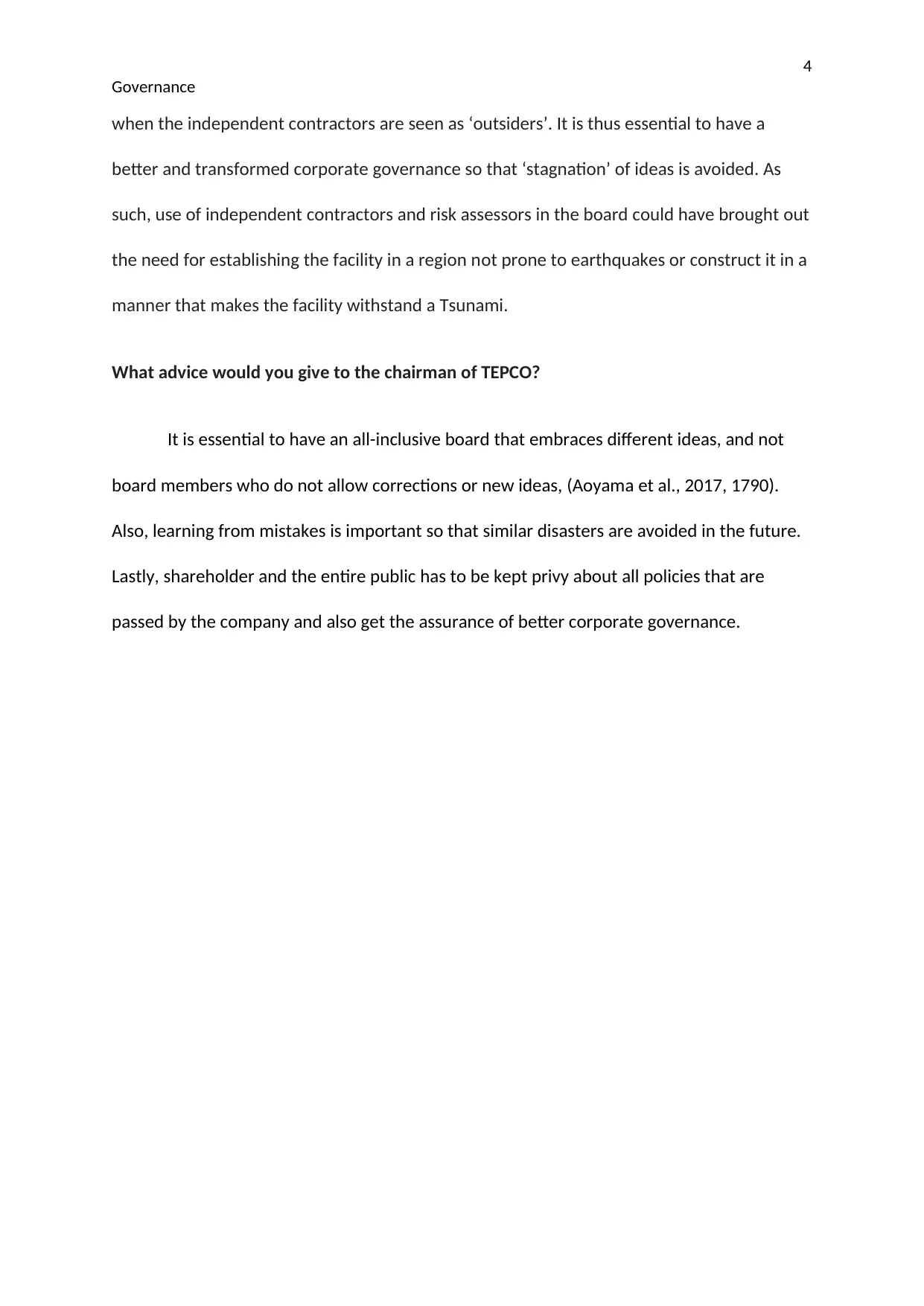
4
Governance
when the independent contractors are seen as ‘outsiders’. It is thus essential to have a
better and transformed corporate governance so that ‘stagnation’ of ideas is avoided. As
such, use of independent contractors and risk assessors in the board could have brought out
the need for establishing the facility in a region not prone to earthquakes or construct it in a
manner that makes the facility withstand a Tsunami.
What advice would you give to the chairman of TEPCO?
It is essential to have an all-inclusive board that embraces different ideas, and not
board members who do not allow corrections or new ideas, (Aoyama et al., 2017, 1790).
Also, learning from mistakes is important so that similar disasters are avoided in the future.
Lastly, shareholder and the entire public has to be kept privy about all policies that are
passed by the company and also get the assurance of better corporate governance.
Governance
when the independent contractors are seen as ‘outsiders’. It is thus essential to have a
better and transformed corporate governance so that ‘stagnation’ of ideas is avoided. As
such, use of independent contractors and risk assessors in the board could have brought out
the need for establishing the facility in a region not prone to earthquakes or construct it in a
manner that makes the facility withstand a Tsunami.
What advice would you give to the chairman of TEPCO?
It is essential to have an all-inclusive board that embraces different ideas, and not
board members who do not allow corrections or new ideas, (Aoyama et al., 2017, 1790).
Also, learning from mistakes is important so that similar disasters are avoided in the future.
Lastly, shareholder and the entire public has to be kept privy about all policies that are
passed by the company and also get the assurance of better corporate governance.
Paraphrase This Document
Need a fresh take? Get an instant paraphrase of this document with our AI Paraphraser
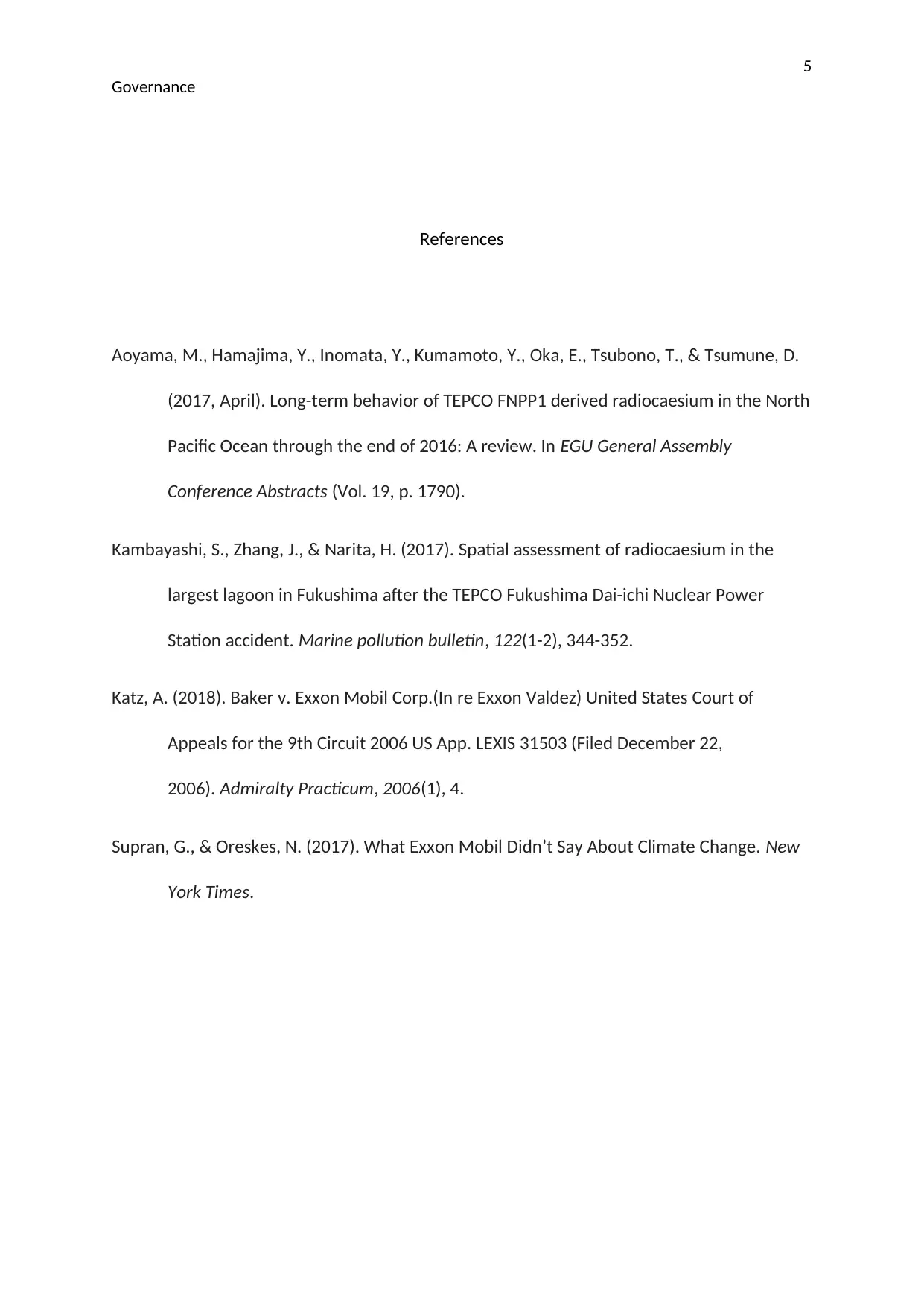
5
Governance
References
Aoyama, M., Hamajima, Y., Inomata, Y., Kumamoto, Y., Oka, E., Tsubono, T., & Tsumune, D.
(2017, April). Long-term behavior of TEPCO FNPP1 derived radiocaesium in the North
Pacific Ocean through the end of 2016: A review. In EGU General Assembly
Conference Abstracts (Vol. 19, p. 1790).
Kambayashi, S., Zhang, J., & Narita, H. (2017). Spatial assessment of radiocaesium in the
largest lagoon in Fukushima after the TEPCO Fukushima Dai-ichi Nuclear Power
Station accident. Marine pollution bulletin, 122(1-2), 344-352.
Katz, A. (2018). Baker v. Exxon Mobil Corp.(In re Exxon Valdez) United States Court of
Appeals for the 9th Circuit 2006 US App. LEXIS 31503 (Filed December 22,
2006). Admiralty Practicum, 2006(1), 4.
Supran, G., & Oreskes, N. (2017). What Exxon Mobil Didn’t Say About Climate Change. New
York Times.
Governance
References
Aoyama, M., Hamajima, Y., Inomata, Y., Kumamoto, Y., Oka, E., Tsubono, T., & Tsumune, D.
(2017, April). Long-term behavior of TEPCO FNPP1 derived radiocaesium in the North
Pacific Ocean through the end of 2016: A review. In EGU General Assembly
Conference Abstracts (Vol. 19, p. 1790).
Kambayashi, S., Zhang, J., & Narita, H. (2017). Spatial assessment of radiocaesium in the
largest lagoon in Fukushima after the TEPCO Fukushima Dai-ichi Nuclear Power
Station accident. Marine pollution bulletin, 122(1-2), 344-352.
Katz, A. (2018). Baker v. Exxon Mobil Corp.(In re Exxon Valdez) United States Court of
Appeals for the 9th Circuit 2006 US App. LEXIS 31503 (Filed December 22,
2006). Admiralty Practicum, 2006(1), 4.
Supran, G., & Oreskes, N. (2017). What Exxon Mobil Didn’t Say About Climate Change. New
York Times.
1 out of 5
Related Documents
Your All-in-One AI-Powered Toolkit for Academic Success.
+13062052269
info@desklib.com
Available 24*7 on WhatsApp / Email
![[object Object]](/_next/static/media/star-bottom.7253800d.svg)
Unlock your academic potential
Copyright © 2020–2025 A2Z Services. All Rights Reserved. Developed and managed by ZUCOL.




